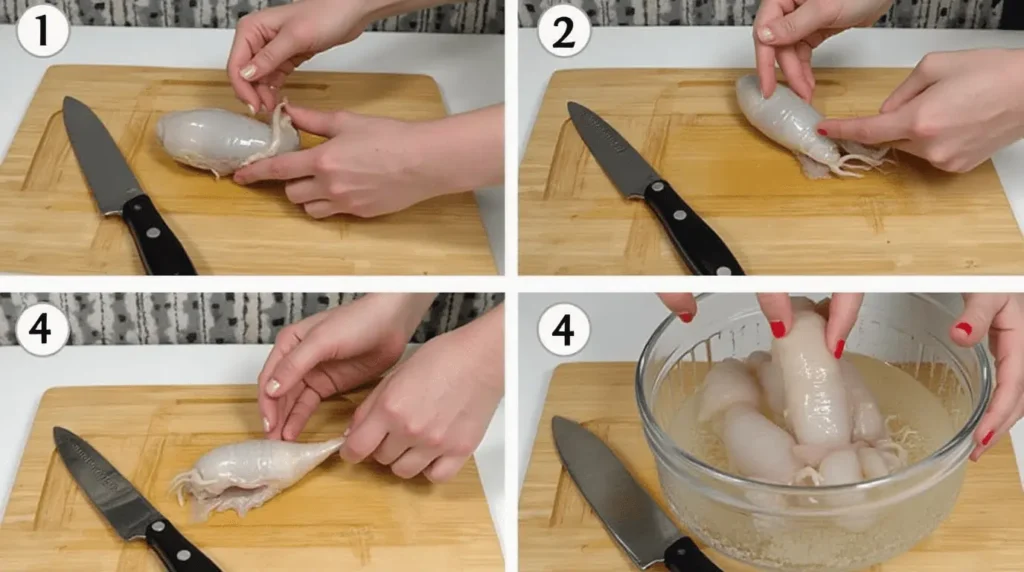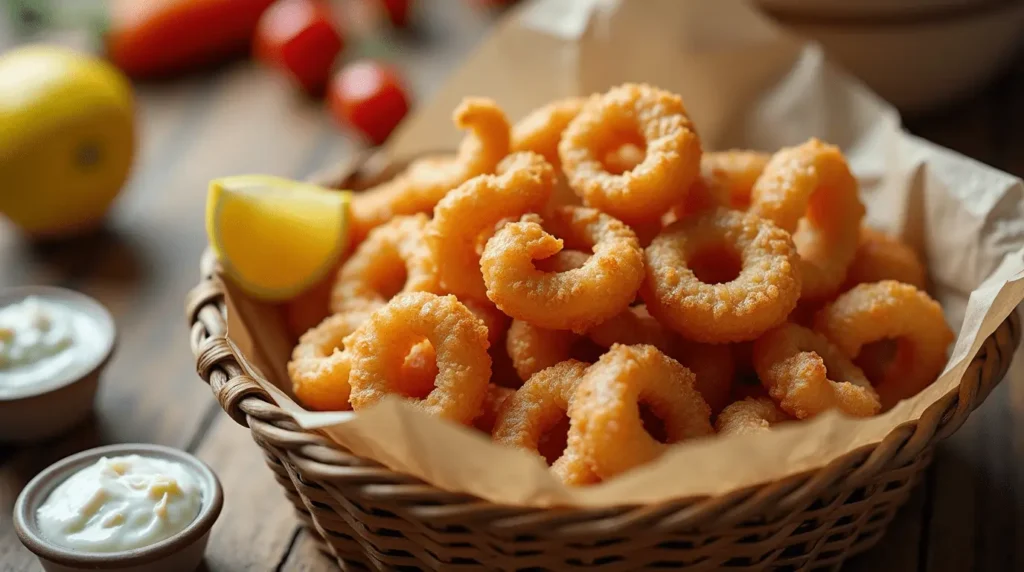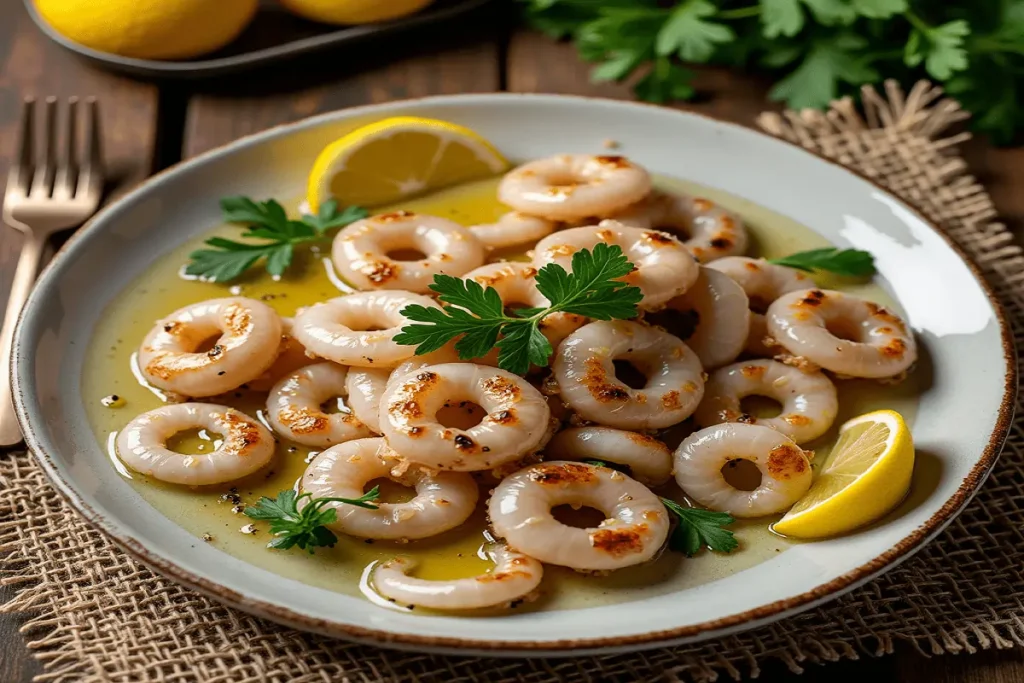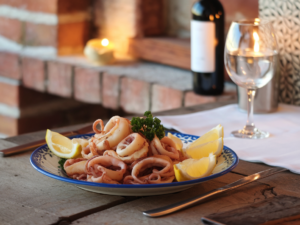How to Cook and Enjoy Baby Squid: Recipes, Tips & More
Delicate, tender, and packed with flavor, baby squid is a seafood delicacy enjoyed worldwide. Whether it’s crispy fried chipirones in Spain, grilled calamaretti in Italy, or stir-fried squid in Asia, this tiny cephalopod makes for a versatile dish in any cuisine.
But what exactly is baby squid? How does it differ from regular squid or calamari? And more importantly, how can you clean, prepare, and cook it to perfection?
In this comprehensive guide, we’ll cover everything you need to know about baby squid, including its nutritional value, cooking techniques, and cultural significance. By the end, you’ll have all the knowledge to cook this delightful seafood at home like a pro!
What is Baby Squid?
Defining Baby Squid
At its core, baby squid refers to young or small squid, usually measuring around 2 to 4 inches in length. Some species are naturally tiny, while others are simply juveniles of larger squid varieties. This seafood is prized for its tender texture, mild briny flavor, and ability to absorb flavors from seasonings and marinades.
Though often confused with calamari, baby squid has a more delicate bite and a slightly sweeter taste, making it a favorite among seafood lovers.
Scientific Classification & Species
Squids belong to the cephalopod family, which includes octopuses and cuttlefish. Some of the most commonly found species of baby squid include:
- Doryteuthis plei – Also known as arrow squid, commonly found in the Atlantic Ocean.
- Loligo vulgaris – The European common squid, often used in Mediterranean cuisine.
- Illex coindetii – A type of shortfin squid found in deep waters.
Each species has subtle differences in taste, texture, and ideal cooking methods, but all share the same tender qualities that make them perfect for a variety of dishes.
Difference Between Baby Squid and Adult Squid
While baby squid is often associated with tenderness, adult squid tends to have a firmer, chewier texture. Here are the main differences:
| Feature | Baby Squid | Adult Squid |
|---|---|---|
| Size | 2-4 inches | 8 inches or more |
| Texture | Soft, tender | Firm, chewy |
| Flavor | Mild, slightly sweet | Stronger, more briny |
| Cooking Time | Short, quick | Longer to soften |
Here’s the continuation of the article with Part 2 and Part 3 while following strict SEO guidelines and readability best practices.
Baby Squid vs. Calamari: Are They the Same?
What is Calamari?
Many people assume that calamari and baby squid are the same, but there’s a subtle difference. Calamari is an Italian word for squid, often referring to a specific culinary preparation rather than a distinct species. In restaurants, “calamari” usually means deep-fried squid rings served as an appetizer.
However, baby squid is not always calamari. While calamari can come from both young and adult squid, baby squid specifically refers to juvenile or naturally small species.
Differences in Texture and Flavor
Although they come from the same family, baby squid and calamari have distinct textures and flavors.
- Baby squid is softer, sweeter, and more delicate, making it ideal for quick cooking methods like grilling or sautéing.
- Calamari—especially from adult squid—is firmer and slightly chewier, requiring tenderizing or slow cooking.
Common Misconceptions About Baby Squid and Calamari
One of the biggest myths is that baby squid is just calamari in its early stages. While some calamari dishes use baby squid, many feature mature squid cut into rings or strips.
Want to learn more about the differences? Check out this guide on the truth about baby squid for more insights!
How to Clean and Prepare Baby Squid

Step-by-Step Cleaning Guide
Before cooking baby squid, you need to clean it properly. Even though it’s smaller than regular squid, it still contains an ink sac, cartilage, and internal organs that should be removed.
Follow these steps:
- Rinse the squid under cold water to remove sand and debris.
- Gently pull the head away from the body—most of the insides will come out with it.
- Remove the clear cartilage (also called the cuttlebone) inside the body.
- Pinch the ink sac carefully to remove it without breaking.
- Cut off the tentacles, just below the eyes. Discard the beak in the center.
- Peel off the skin (optional)—some prefer to leave it for extra flavor.
- Pat dry and your baby squid is ready to cook!
Removing Ink and Internal Organs
Squid ink is often used in gourmet dishes, but for most home recipes, it’s removed. If you want to keep the ink, handle it gently while pulling out the organs and store it in a separate container.
Tips for Tenderizing Baby Squid
- Avoid overcooking! Baby squid becomes tough if cooked too long. Quick high-heat cooking (grilling, sautéing, or frying) keeps it tender.
- Use buttermilk or lemon juice to break down proteins if you plan to fry it.
- Freeze before cooking—a brief freeze softens the texture without changing the flavor.
Popular Ways to Cook Baby Squid
Grilled Baby Squid (Calamaretti alla Piastra)
One of the best ways to enjoy baby squid is grilling it over high heat. The smoky char enhances its natural sweetness, making it a perfect dish for seafood lovers.
How to Make It:
- Clean the baby squid and pat it dry.
- Marinate it in olive oil, garlic, lemon juice, salt, and pepper for at least 15 minutes.
- Heat a grill or cast-iron pan until very hot.
- Grill each squid for 1-2 minutes per side until lightly charred.
- Serve with a drizzle of olive oil and fresh parsley.
This dish pairs beautifully with a crisp white wine and fresh salad!
Seared Baby Squid with Garlic and Parsley
If you’re short on time, a quick sear in a hot pan works wonders. This Mediterranean-style dish brings out the delicate flavors of baby squid with just a few simple ingredients.
How to Make It:
- Heat olive oil in a pan over medium-high heat.
- Add minced garlic and sauté for 30 seconds.
- Toss in the cleaned baby squid and sear for 2-3 minutes.
- Sprinkle with salt, pepper, and chopped parsley.
- Finish with a squeeze of lemon juice.
Deep-Fried Baby Squid (Chipirones Fritos)
For a crispy and indulgent option, try deep-frying baby squid. This Spanish-style dish, known as chipirones, is a crowd-pleaser.
How to Make It:
- Dredge cleaned baby squid in seasoned flour.
- Shake off excess and fry in hot oil (375°F) for 1-2 minutes.
- Drain on paper towels and season with salt.
- Serve with aioli or a wedge of lemon.
Looking for more seafood recipes? Check out The Truth About Baby Squid for more inspiration!
Nutritional Value and Health Benefits of Baby Squid
Protein and Essential Nutrients
Baby squid is not only delicious but also packed with nutrients. It’s an excellent source of:
- Protein – Essential for muscle growth and repair.
- Omega-3 fatty acids – Supports heart and brain health.
- Vitamins B12 and B6 – Important for energy and metabolism.
- Iron and zinc – Boosts immune function and overall well-being.
Low-Calorie and High-Protein Benefits
For those watching their calorie intake, baby squid is a fantastic choice. It’s naturally low in fat while being high in protein, making it great for a balanced diet.
| Nutrient | Per 100g |
|---|---|
| Calories | 90 kcal |
| Protein | 16g |
| Fat | 1.5g |
| Omega-3 | 0.5g |
It’s a perfect option for those looking to eat healthier without sacrificing flavor!
Omega-3 Fatty Acids and Heart Health
Seafood, including baby squid, is known for its heart-healthy omega-3s. These fatty acids:
- Reduce inflammation.
- Lower bad cholesterol (LDL).
- Support brain function.
Regular consumption of baby squid can be beneficial for long-term heart health.
Baby Squid in Different Cuisines Around the World
From Mediterranean tapas to Japanese seafood markets, baby squid is enjoyed in many ways across the globe. Its delicate texture and mild flavor make it a perfect match for a variety of seasonings and cooking methods.

Mediterranean Baby Squid Dishes
In Mediterranean cuisine, baby squid is a staple ingredient. Whether grilled, fried, or stewed, it’s a favorite among seafood lovers.
- Spain: Chipirones fritos (deep-fried baby squid) is a popular tapa, often served with aioli and lemon.
- Italy: Calamaretti alla griglia (grilled baby squid) is drizzled with olive oil and fresh herbs.
- Greece: Kalamari yemista features baby squid stuffed with rice, tomatoes, and feta cheese.
Japanese and Korean Baby Squid Specialties
In East Asia, baby squid is prepared in unique and flavorful ways.
- Japan: Hotaru ika (firefly squid) is often eaten raw with soy sauce or served as sushi. These tiny squid are famous for their bioluminescent glow.
- Korea: Ojingeo-bokkeum is a spicy stir-fry dish featuring squid, vegetables, and gochujang (Korean chili paste).
Spanish Tapas: Chipirones and Puntilla Squid
Spain offers some of the most famous baby squid dishes. Chipirones are lightly battered and fried, creating a crispy yet tender bite. Meanwhile, puntilla squid—a smaller variety—is often sautéed with garlic and parsley.
No matter the country, baby squid remains a sought-after seafood, bringing bold flavors and versatility to many dishes.
Where to Buy Baby Squid and How to Store It
Fresh vs. Frozen Baby Squid
When buying baby squid, you’ll often find two options: fresh or frozen.
- Fresh baby squid has a mild ocean scent, firm texture, and clear skin. It should be used within a day or two for the best quality.
- Frozen baby squid is flash-frozen to preserve freshness and can be stored for months. Thaw it in the fridge overnight for the best results.
Best Places to Purchase Baby Squid
Finding high-quality baby squid depends on where you shop.
- Local fish markets: The best place to get fresh squid straight from the source.
- Asian grocery stores: Many carry frozen or fresh baby squid, often at great prices.
- Online seafood suppliers: If you don’t have access locally, many online stores ship baby squid right to your door.
Storage Tips for Maintaining Freshness
To keep baby squid at its best:
- Store fresh squid in the coldest part of your fridge and use it within 24-48 hours.
- If freezing, place it in an airtight container to prevent freezer burn.
- Once thawed, never refreeze baby squid, as it can affect the texture.
Buying and storing baby squid properly ensures you always have the freshest seafood for your meals!
Frequently Asked Questions About Baby Squid
When it comes to baby squid, many people have questions about its preparation, uses, and differences from other seafood. Here are answers to some of the most commonly asked questions.
Is Calamari a Baby Squid?
Not necessarily! Calamari is a general term for squid dishes, often referring to fried squid rings. While baby squid can be used for calamari, most restaurant calamari comes from larger squid that have been sliced into rings.
What is Baby Squid?
Baby squid can refer to juvenile squid or naturally small squid species. They are typically 2 to 4 inches long and are prized for their tender texture and mild flavor.
Can You Eat All Parts of a Baby Squid?
Yes! Most parts of baby squid are edible, including the tentacles, body, and ink. However, the internal organs, beak, and cartilage (cuttlebone) are usually removed before cooking. Some recipes use the ink for sauces and pasta.
Are Chipirones Baby Squid?
Yes, chipirones is the Spanish term for baby squid, often served fried as a tapa. These tiny squid are popular in Mediterranean cuisine, especially in Spain and Italy.
Grilled Baby Squid (Calamaretti alla Piastra)
Equipment
- Grill or Cast-Iron Pan
- Mixing bowl
- Tongs
Ingredients
Marinade
- 2 tbsp olive oil
- 1 tbsp lemon juice freshly squeezed
- 2 cloves garlic minced
- 1/2 tsp salt or to taste
- 1/4 tsp black pepper freshly ground
- 1 tsp fresh parsley chopped
Baby Squid
- 1/2 lb baby squid cleaned
- 1 lemon wedges for serving
Instructions
- In a mixing bowl, combine olive oil, lemon juice, minced garlic, salt, black pepper, and chopped parsley to create the marinade.
- Add the cleaned baby squid to the marinade and toss to coat. Let sit for at least 10 minutes.
- Preheat a grill or cast-iron pan over high heat until very hot.
- Grill the squid for 1-2 minutes per side, or until lightly charred and opaque.
- Remove from heat and drizzle with extra olive oil. Serve immediately with lemon wedges.
Notes
Conclusion

Baby squid is a versatile seafood that brings incredible flavors to many dishes worldwide. Whether grilled, fried, or stir-fried, it delivers a tender bite and rich taste that seafood lovers adore.
From Mediterranean chipirones to Japanese hotaru ika, baby squid plays a key role in many global cuisines. Plus, it’s packed with protein, omega-3 fatty acids, and essential nutrients, making it a healthy addition to your diet.
Buying and storing baby squid correctly ensures that you always have the freshest ingredient for your meals. Whether you get it fresh from a seafood market or frozen from an online supplier, proper handling will keep its texture and flavor intact.
Now that you know everything about baby squid, why not try a new recipe? Whether you grill it, sear it, or deep-fry it, this small but flavorful seafood is sure to impress.

